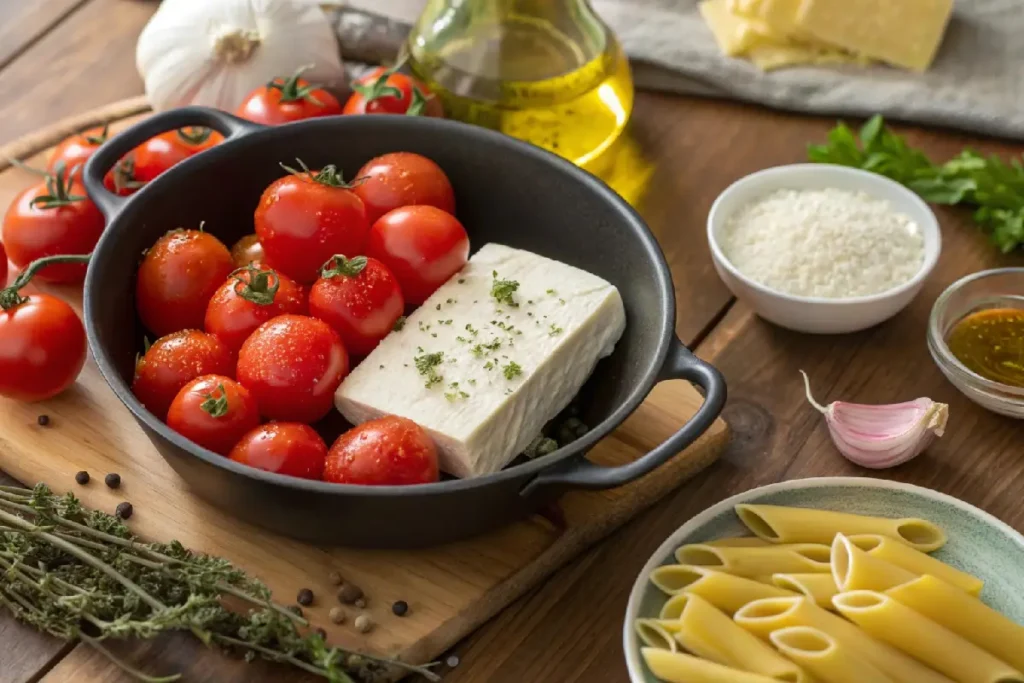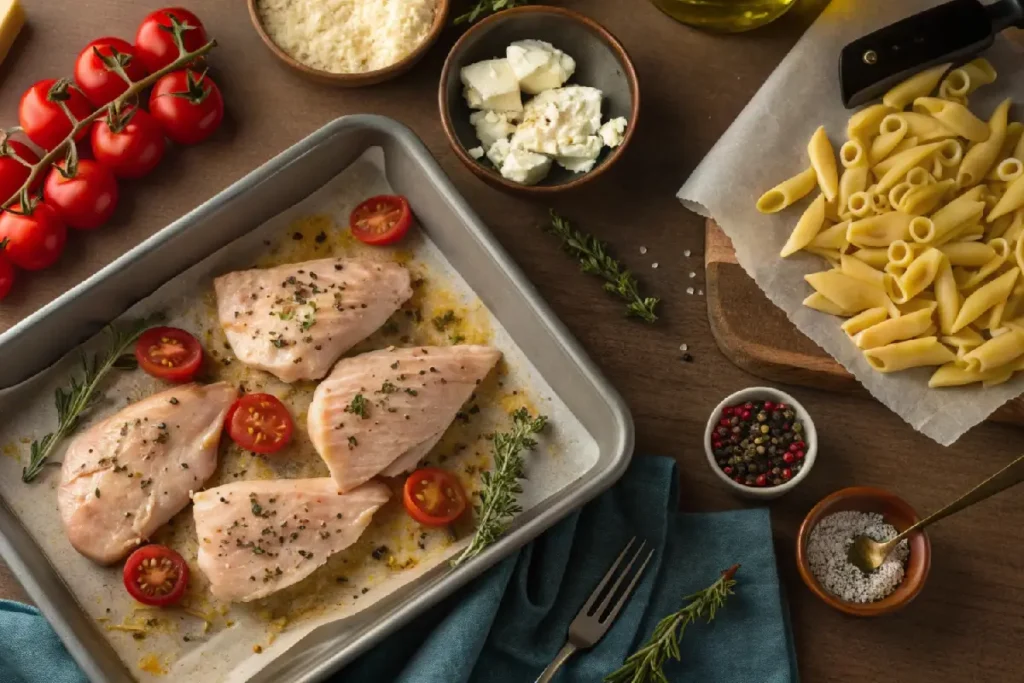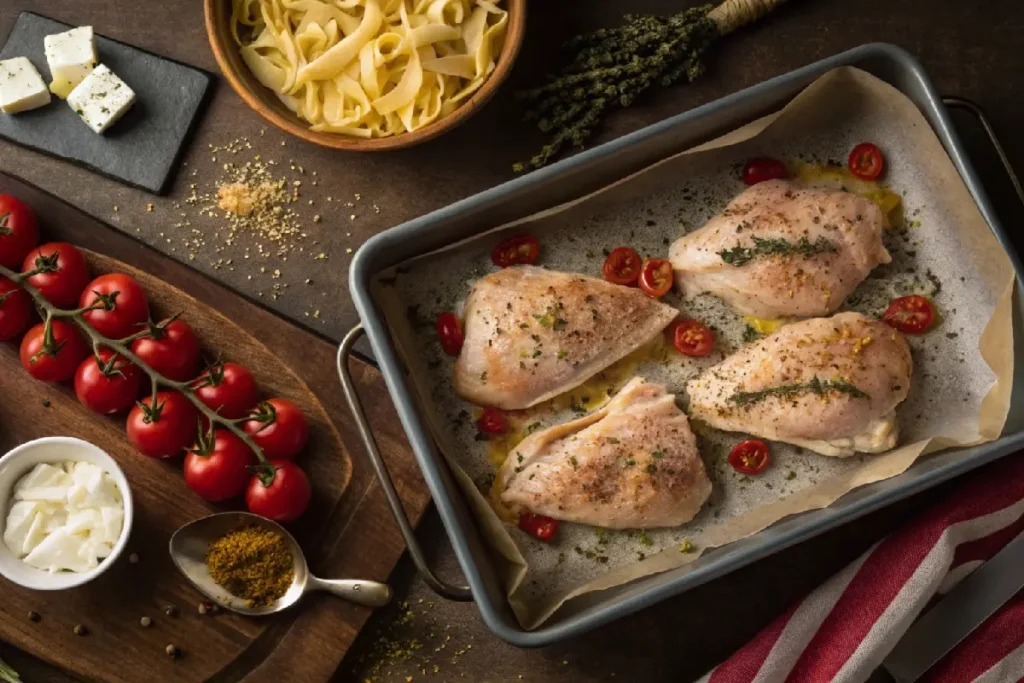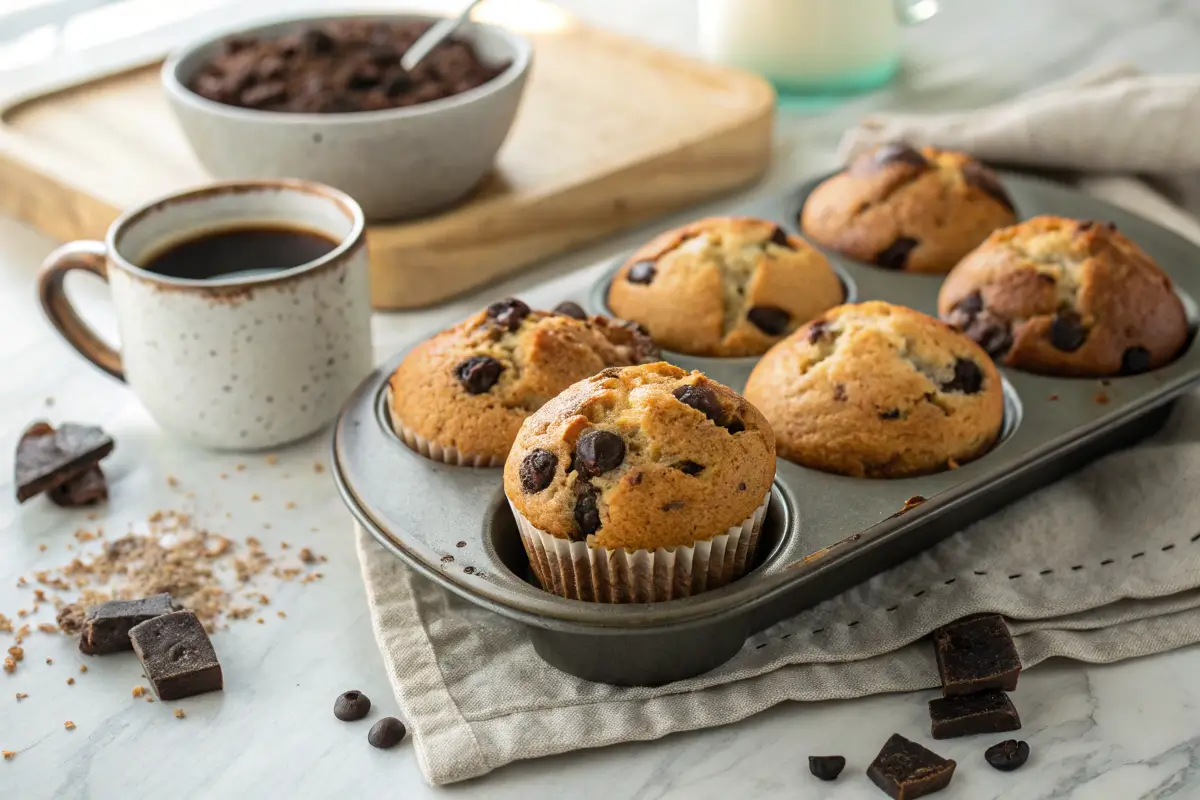Ready to learn all about sheet pan feta pasta? This dish, brimming with baked feta and Mediterranean flavors, has taken the culinary world by storm. We’ll explore its historical roots, learn how to create a foolproof one-pan meal, and discover unique flavor twists. Plus, we’ll delve into the rise of this viral TikTok pasta and ways to make it healthier and more exciting. Let’s embark on this pasta journey!
Understanding the “Sheet Pan Feta Pasta”
History and Origins of Baked Feta
Surprisingly, baked feta isn’t a modern-day creation sprouting from social media. In fact, it’s been a part of Greek cuisine for centuries, warming plates with its tangy flavor and creamy texture. Although the exact origin of baking feta with tomatoes and herbs isn’t clear, it’s likely that it emerged during simpler times when Greek families utilized seasonal ingredients. Notably, by creatively combining veggies with hearty cheese, they laid the groundwork for what we now call tray bake pasta. Consequently, this mouthwatering mix forms the base of roasted feta tomato pasta.
How One-Pan Meals Reached Viral Popularity
In today’s fast-paced world, we all understandably crave simple pasta dinners. Who wants to juggle multiple pans and complex steps? Certainly not us! It’s this desire for simplicity that spurred the rise of one-dish feta pasta. Interestingly, the dish’s popularity surged, in part due to home cooks showcasing their sizzling pans on social media. The concept is simple—toss everything onto a sheet pan, bake, and enjoy an easy weeknight dinner. As a result, this viral trend quickly spread, teaching millions how to create this savory dish with roasted tomatoes, creamy feta, and a rich tomato sauce. Given the simple ingredients and effortless preparation, it’s no wonder that sheet pan feta pasta became a sensation.
Key Ingredients for the Perfect Sheet Pan Feta Pasta
Selecting the Best Feta Cheese and Tomato Varieties
When making sheet pan feta pasta, choosing the right feta cheese is crucial. Your choice will greatly affect the dish’s tangy flavor and creaminess. Many prefer Greek feta from sheep’s milk, as it melts beautifully into a creamy sauce. If you enjoy a sharper taste, goat’s milk feta is a great alternative. Avoid feta crumbles or low-fat versions, as they often lack the rich texture needed for baked feta.
Additionally, your tomatoes are important. Small cherry tomatoes look beautiful in tray bake pasta and burst easily, creating a flavorful sauce. If you can’t find cherry tomatoes, Roma tomatoes work well—just slice them in half for even roasting. To elevate the meal, consider adding garlic-infused touches, like minced garlic or garlic oil. With the right tomatoes and feta, you’re halfway to an epic one-dish pasta.
Savor the Flavor! If you enjoyed our guide on Baked Feta with Vegetables, dive into more delicious recipes that will elevate your cooking game! Discover how to create mouthwatering meals that impress every time!
Exploring Different Pasta Shapes and Their Cooking Times
While many cooks use short pasta shapes like penne or fusilli, experimenting with other shapes can yield new textures. For example, cavatappi catches sauce perfectly, while rigatoni offers a satisfying bite. However, keep an eye on cooking times, as some shapes absorb sauce faster.
To achieve a quick oven-baked pasta that is tasty and al dente, slightly undercook your pasta before adding it to the pan. Let the oven finish cooking it. If you want a healthy twist, consider whole wheat or legume-based pasta. These options add protein and fiber without sacrificing flavor, but be mindful of their shorter cook times. Balancing the pasta with enough liquid from tomatoes, olive oil, and feta will create a dreamy Mediterranean flavor that complements every swirl of noodles.
Step-by-Step Guide to Sheet Pan Feta Pasta

Preparing Your Sheet Pan Base: Layering Techniques
First, prepare your ingredients on a sturdy baking tray. Create an even layer of tomatoes, ensuring they have room to roast rather than steam. Next, sprinkle your choice of fresh herbs, like basil, oregano, or thyme, to infuse the tomatoes with bold flavors. Drizzle olive oil generously to help the tomatoes soften. For extra taste, add chili flakes or crushed garlic.
Now, place the feta in the center of the pan, nestling it among the tomatoes to form a saucy base. Lightly coat the feta with olive oil and sprinkle a dash of pepper on top to help it crisp during baking. This layering creates a foundation for a savory roasted feta tomato pasta that transforms into a creamy sauce.
Proper Baking Temperature and Timing for Roasted Feta
Aim for a baking temperature of about 400°F (200°C). This heat will blister the tomatoes and soften the feta quickly. Bake for 25 to 30 minutes, or until the tomatoes burst and release their sweet juices. Once out of the oven, stir everything together. The melted feta will blend with the roasted tomatoes to form a velvety sauce. Finally, fold in your al dente pasta, garnish with fresh herbs or olive oil, and watch everyone enjoy your glorious sheet pan feta pasta!
Fall in Love with Cooking! Ready to impress your special someone? Check out our Marry Me Chickpeas recipe for a romantic meal that’s sure to win hearts! Explore more romantic dishes that will make your dinner unforgettable!
Flavorful Variations of Sheet Pan Feta Pasta

Adding Seasonal Vegetables and Herbs to Your Sheet Pan Feta Pasta
While the classic roasted feta tomato pasta is delicious, adding seasonal veggies keeps your meal fresh. Consider tossing in zucchini slices, red onions, or bell peppers. These additions introduce color and healthy ingredients that complement the tangy cheese flavor. You can also switch up the herbs, using rosemary in cooler months and basil in warmer weather. Add the herbs when you include the tomatoes to allow the flavors to meld into a creamy sauce. For those who enjoy spice, add jalapeños or red chili flakes for a kick. Remember that different veggies have varying cooking times, so chop them into bite-sized pieces for even roasting. Ultimately, these tweaks let you create a one-dish feta pasta tailored to your taste.
Incorporating Proteins: Chicken, Shrimp, or Plant-Based Options
Many enjoy a protein boost with their pasta dinners. Fortunately, sheet pan feta pasta pairs well with lean meats like chicken or shrimp. For chicken, cut it into cubes and place it with the tomatoes and feta before baking. This way, it marinates in savory juices as everything roasts. If using shrimp, add them about halfway through to prevent overcooking. Alternatively, plant-based options like chickpeas, lentils, or tofu cubes offer satisfying twists. They absorb the Mediterranean flavors while adding protein and fiber. A sprinkle of seasoning or paprika can enhance the smoky notes. By integrating your favorite protein, you elevate this viral TikTok pasta from a light meal to a hearty feast.
Chickpea Magic Awaits! Curious about the secrets behind our Marry Me Chickpeas? Don’t miss our comprehensive guide that reveals tips and tricks for making this dish a showstopper! Your culinary adventure starts here!
Common Mistakes and How to Avoid Them
Preventing Soggy Pasta and Maintaining Creamy Texture
Although sheet pan feta pasta is known for its silky sauce, soggy noodles can be a common problem. To avoid this, it’s crucial to cook your pasta just shy of al dente. This means that the pasta should still have a slight firmness when bitten into. By doing so, it will absorb extra juices while still maintaining its structure. If you cook it fully before baking, it may become mushy in the oven.
Furthermore, it’s important to monitor your vegetables for excess liquid. Tomatoes, in particular, can release a lot of moisture during roasting. This moisture may dilute your sauce, leaving you with a watery dish instead of the rich, creamy texture you desire. To counter this, you can add a drizzle of olive oil and a sprinkle of salt. This method not only helps the vegetables caramelize but also enhances their flavor, preventing them from stewing in their juices.
In addition, keep the feta as a solid block instead of crumbles. A whole block of feta will maintain its shape and texture during baking. This allows it to develop a lovely, crispy exterior while remaining creamy in the center. When you remove the tray from the oven, you should stir everything together gently. This blending of roasted tomatoes, tangy cheese, and pasta creates a harmonious dish that’s both satisfying and visually appealing.
Vegan Delights Just for You! Looking for plant-based options? Our Vegan Marry Me Chickpeas Recipe is a must-try! Explore more vegan recipes that are not only delicious but also easy to prepare!
Moreover, consider the order in which you add your ingredients. Placing the feta in the center of the tray surrounded by tomatoes and pasta allows the flavors to meld beautifully. As the ingredients roast, the feta releases its creamy goodness, combining perfectly with the tomatoes to create a luscious sauce. Therefore, the arrangement in your sheet pan can significantly impact the final texture and taste of your pasta.
Balancing Flavors with the Right Amount of Seasoning
Sometimes, tray bake pasta can turn out bland without enough seasoning. To prevent this, be generous with staples like salt, pepper, and oregano. These basic seasonings can elevate the overall taste of your dish. Additionally, a dash of dried chili flakes adds a nice zing to your baked feta, enhancing its flavor profile.
As you prepare your dish, taste as you go. This practice is essential for achieving the perfect balance of flavors. Start with a small amount of seasoning, then gradually adjust according to your preferences. Since feta cheese is already salty, it’s wise to conduct a quick taste test to avoid oversalting your dish.
Furthermore, consider incorporating other herbs and spices to enhance the flavor. Fresh basil, for example, can add a bright, aromatic quality to your sheet pan feta pasta. Alternatively, a sprinkle of smoked paprika can introduce a subtle smokiness that pairs well with the roasted vegetables. Experimenting with different herbs not only enriches the flavor but also adds variety to your meal.
Additionally, don’t forget about acidity. A splash of lemon juice or a drizzle of balsamic vinegar can brighten up the dish and balance the creaminess of the feta. The acidity will cut through the richness and provide a refreshing contrast.
By striking this balance, your easy weeknight dinner will shine each time! Remember, cooking is as much about experimentation as it is about following recipes. Embrace the process and feel free to add your personal touch. As you refine your technique, you’ll discover what flavors and textures work best for you. This way, your sheet pan feta pasta will not only become a go-to meal but also a beloved favorite among family and friends.
Join the Flavor Journey! Love what you’ve read? There’s so much more to discover! Explore our blog for a treasure trove of recipes and cooking tips that will inspire your next meal. Let’s cook up something amazing together!
Serving and Presentation Ideas for Sheet Pan Feta Pasta

From Casual Family Dinners to Sophisticated Gatherings
You can easily dress up or down sheet pan feta pasta depending on your audience. For instance, for a casual family night, simply place the tray in the center of the table and let everyone serve themselves. Moreover, adding some crusty bread on the side allows guests to soak up any leftover creamy tomato sauce. Since this dish comes together in one pan, it is perfect for busy evenings or last-minute gatherings.
On the other hand, if you want to impress, transform this roasted feta tomato pasta into an elegant dish. Specifically, plate each serving individually, garnishing with fresh basil and a drizzle of high-quality olive oil for a refined look. Additionally, if you’re hosting a dinner party, consider pairing the meal with a crisp white wine to balance the tangy cheese flavor. Ultimately, thoughtful finishing touches can elevate your sheet pan feta pasta from casual to classy.
Garnishes, Sauces, and Sides to Elevate the Dish
While this one-dish feta pasta is delicious on its own, adding a few extras can make it shine even brighter. For example, a sprinkle of crushed red pepper or chopped parsley adds vibrant color. Furthermore, stirring in a spoonful of pesto brings a delightful Mediterranean flavor twist. If you enjoy robust tastes, you can also add a splash of balsamic reduction for a sweet and tangy kick.
In terms of sides, roasted vegetables like asparagus or broccoli pair well with the pasta’s bold taste. Additionally, a simple tossed salad with a zesty vinaigrette helps cleanse your palate between bites. Ultimately, these details keep your meal balanced, which is why sheet pan feta pasta has become a favorite easy weeknight dinner. Therefore, feel free to experiment with various herbs, cheeses, and sides to suit any vibe you’re aiming for!
If you loved the viral Baked Feta Pasta from TikTok, you’re in for a treat! Explore more delicious recipes on our blog that will take your cooking to the next level.
FAQs:
Can I Use a Different Cheese for a Feta Tray Bake?
Yes, you can. However, swapping the feta will alter the sheet pan feta pasta flavor profile. Goat cheese, for instance, gives a stronger tang, while ricotta offers a milder, fluffier texture. Keep in mind, some cheeses melt faster, so watch your bake time to avoid losing that creamy tomato sauce factor.
Why Does My Baked Feta Pasta Turn Out Dry or Watery?
Your pasta may dry out if you use too little olive oil or bake it too long. Conversely, it can become watery if the tomatoes release excess liquid before they caramelize. Thus, striking a balance with your ingredients and cooking times is key for that perfect one-dish feta pasta.
How Long Can I Store Leftover One-Pan Feta Pasta?
In most cases, it keeps well in an airtight container in the fridge for up to three days. Reheat gently on the stovetop or in the microwave with a splash of water to maintain moisture.
Is Roasted Feta Pasta Healthy and Nutritious?
Despite its tangy cheese richness, it can be a balanced option if you use fresh tomatoes, whole-grain pasta, and control your oil. Ultimately, you can tailor your sheet pan feta pasta to meet your dietary needs by tweaking veggies, herbs, and portion sizes!
Conclusion
Final Thoughts on Mastering Sheet Pan Feta Pasta
Mastering sheet pan feta pasta revolves around balancing fresh ingredients, proper techniques, and creativity. First, select high-quality feta cheese and vibrant tomatoes to ensure your dish showcases tangy flavors and sweet undertones. Next, arrange them on a single tray with aromatic herbs and a generous drizzle of olive oil. Let the oven handle the cooking.
After baking, stir in your al dente pasta for a creamy tomato sauce that coats every bite. Don’t hesitate to experiment with different veggies, proteins, or seasonings. These variations allow you to personalize your one-dish feta pasta for any taste. Additionally, monitor cooking times to maintain the perfect texture.
By following these tips, you can create an easy weeknight dinner or a sophisticated centerpiece for entertaining. Mastery comes from practice, so enjoy each delicious experiment with sheet pan feta pasta! You’ll impress your friends with your newfound expertise!







1 thought on “Sheet Pan Feta Pasta: The Ultimate Guide”